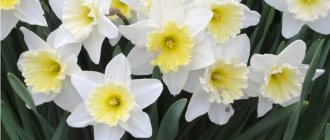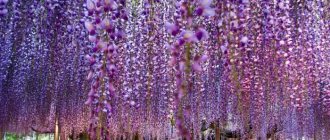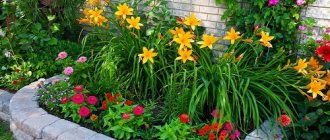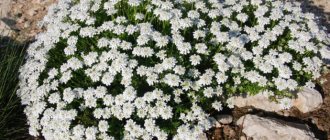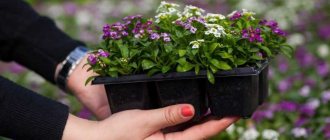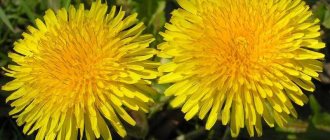Low-growing flowers play a special role in landscape design - they are suitable for creating flower beds (flower beds with strict outlines), as well as borders, they can be effectively present in tiered compositions (including on rocky hills) and fill free space under trees. Each season, certain low-growing flowers are especially loved by gardeners because they bloom all summer and are unpretentious.
Iberis
The most common plant is the annual Iberis umbellata. The branches of its spreading bushes up to 30–40 cm are not covered with fluff, like many other varieties.
In order for Iberis to bloom from May to September, its seeds are sown directly into the ground in April 2 times with an interval of 2-3 weeks. Also, for a full-fledged decorative appearance, Iberis needs:
- in moderate application of fertilizers - an excess leads to the growth of greenery;
- no transplants - if the taproot is damaged, the plant dies;
- loamy soil, well permeable to air and water;
- systematic removal of flowering shoots to form new buds.
Designers advise combining Iberis with evergreens, such as cypress and juniper. Iberis is also harmonious with large bells, tulips, as well as with drought-resistant ground covers such as sedum, creeping tenacious and creeping phlox.
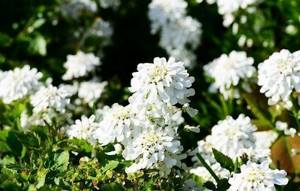
Caring for indoor plants outdoors
How to water flowers outside? When the heat lasts for several days, the plants need generous watering. Never water a flower under bright sun! Wait until evening or water in the morning, while the sun is not so hot. Plants with large leaves especially need water. You should only use warm water for watering; under no circumstances do you water with water from a well - you will destroy the plant!
How to feed flowers that live outside in summer? Once every two weeks, add a fertilizer suitable for the flower to the water for irrigation in the amount specified by the manufacturer. This feeding should be enough.
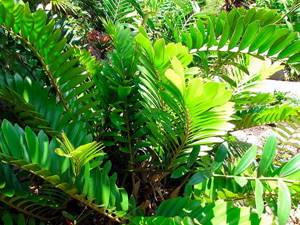
How to avoid overwatering flowers? Houseplants outdoors should not be kept in pots - water collects there after rain. Make sure that there is enough moisture in the trays, and also check that the drain holes are not clogged - insects can get in there.
- Jacaranda - care, photos, types
By the way, about insects. Don't forget to inspect plants exposed to fresh air. They can be pestered by aphids and slugs. Signs of aphids appearing on a plant: sticky, curled leaves, drying young shoots. Spraying with soapy water or nettle infusion will help get rid of aphids. All affected shoots must be removed.
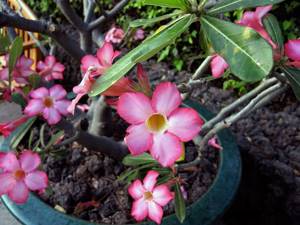
Another problem that can ruin your indoor flowers' summer holidays is spider mites. It does not tolerate moisture, so simply bathe the mite-infested plant.
If you notice bitten leaves, it means that slugs have found their way to your flower. Place the pot in a shallow container of water - this will be the most convincing argument for slippery guests to forget the way to your flower.
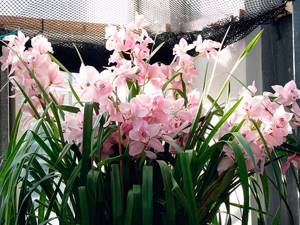
If you want to take the vine outside, arrange it in the yard so that in the fall, when it’s time to return the flower indoors, you don’t have to “untangle” it.
If the plant is too tall or bulky, it is better to bury it (with or without a pot) so that a gust of wind cannot damage the plant - drop it or break it.
Petunia
Shade is contraindicated for this flower in the area, and it also needs regular weeding, loosening and mulching of the soil for proper breathing of the root system.
In addition, petunias need potassium supplements once every 2 weeks all summer until August.
Petunia varieties are in great demand among gardeners:
- Flame - red flowers adorn the bush from June to September, the variety is distinguished by its demands on long daylight hours and tolerates drought well;
- Stormy sky - cream-colored inclusions are scattered across the purple velvety petals in dots and strokes;
- Jolly lemon yellow - attracts with its unusual yellow color for petunias and the fact that the compact bushes are densely strewn with flowers. The variety is not afraid of windy and rainy weather.
Even for the southern regions, it is recommended to grow petunia through seedlings - by providing the plant with ideal conditions in the early stages of its life, you can easily keep it in the garden in the future.
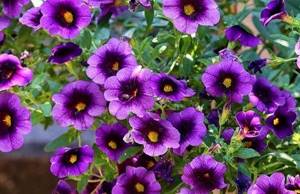
The bright beauty of annuals
Of course, annual flowers cannot compete with perennials in terms of labor costs.
In the spring they need to be planted as seedlings and then transplanted into the ground. But there is no need to prepare them for wintering, as is the case with perennial plants .
They are able to decorate any garden plot with their brightness and aroma. Moreover, decorate for a long time. Thus, zinnia blooms all summer and half of autumn, nasturtiums and calendulas delight summer residents from mid-summer until frost.
Alyssums, cornflowers, begonias and poppies are distinguished by early flowering.
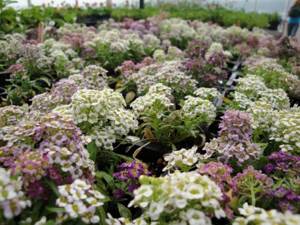
Alyssum
Traditionally, annuals are grown from seeds. After just 13 weeks, some flowers begin to bloom. Some - through seedlings, which allows you to speed up flowering.
When choosing annuals, you need to pay attention to the composition of the soil, the degree of illumination of the area, the level of humidity, the possibility of regular watering, and the color scheme of the flower garden.
For example, morning glory does not tolerate drafts, purslane loves soil mixed with sand, aster prefers sunny areas, and touching bell does not tolerate excessive moisture.
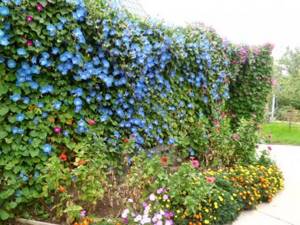
morning glory
Annual plants that are correctly selected according to their flowering time will allow you to create spectacular compositions that do not change their aesthetics all summer long.
It is the annuals that hold the record for the longest flowering time. While perennials delight the eye for several weeks, annual plants can bloom for up to four to six months.
Annual flowers also come in different heights:
- The smallest are escholzia, dwarf phlox, and low-growing marigold. Purslane and lobelia are also low-growing flowers. They go well with taller annual and perennial plants and are used to design garden paths and alpine slides.
- that can branch and bush are also popular . For example, petunia, beloved by all summer residents, or castor bean, which can grow to the size of a small tree. The largest “army” of annuals is medium-growing plants. These are: snapdragon, nasturtium, dahlia. Climbing plants are also among the medium-growing ones.
- Tall include : morning glory vine, annual delphinium, and spectacular sunflower. The fragrant mallow, an annual hollyhock, often decorates garden plots. Most of all, such flowers are suitable for decorating fragrant front gardens. Such plants can bloom all summer, which many perennials are unable to do.
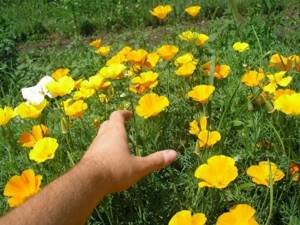
In the photo, Esholtia is an annual flower that blooms all summer
Fences and arches are decorated with climbing annuals, and cascading bushes will help make a terrace or balcony in the country cozy.
Arabesque flower beds, mixborders along the garden path, edgings - all you have to do is decide on your own aesthetic preferences and choose flowers that will feel organically in your garden plot.
Ageratum
In garden design, ageratum is especially effective when densely planted in small groups or lines that act as color spots against the background of other plants. Ageratum looks elegant and harmonious next to snapdragons, titonias, heliopsis, cleomes and rudbeckias.
Among the many varieties of ageratum, it is worth paying attention to the following:
- Blue mink - belongs to the species Ageratum Mexicana, grows 20–25 cm tall, the inflorescences are literally fluffy, sky blue;
- Pink Deer - similar to the Blue Mink, but in accordance with the name, it is different in color;
- Blue Ball - does not exceed 18 cm in height, inflorescences are 2 cm in diameter, lilac with a blue tint, form spherical bunches.
In order for ageratum to take root well in the garden, it is important not to miss the time for sowing seedlings - from mid-March to mid-April. It is recommended to plant the flower on light sandy soils.
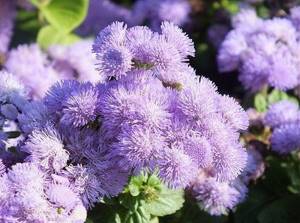
Perennial inhabitants of the dacha
Unpretentious perennial flowers that retain their decorative value for several years are divided into two types:
- Rhizomatous plants overwintering in the ground .
- Perennials that do not overwinter in the ground , do not tolerate temperature changes and require annual digging and transfer to special storage facilities. It is this factor that you should pay attention to when choosing flowers for your garden.
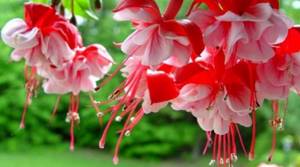
Fuchsia
Perennials that perfectly adapt to harsh climatic conditions include delphiniums, asters, lupins, peonies, lilies of the valley, fuchsias, phlox, coreopsis, primroses, astilbes and many others.
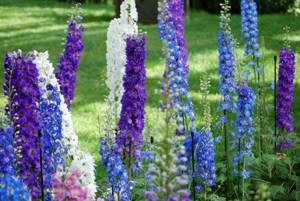
In the photo, Delphinium is one of the perennials that pleases the eye all summer
The second group consists of strikingly beautiful gladioli, dahlias, cannas and montbretia.
Perennial flowers bloom all summer and are divided by height, allowing you to create unforgettable compositions:
- Low-growing representatives of perennials are the best solution for garden paths and flower bed borders. These are mountain gerbil, saxifrage, bearded iris, and carnation. Low-growing flowers are also distinguished by their love of sunshine. So, in the shade, coin loosestrife and lesser periwinkle feel great, and in the sun - alpine rhizome, field moth and others.
- Medium - growing perennial flowers that are popular among summer residents include: paniculate phlox, peony, and Turkish carnation. The height of perennials classified as medium-growing does not exceed 80 centimeters. Such flowers become an integral part of flower beds and flower beds, organically combining with their short and tall counterparts.
- Tall perennials, such as asters, dahlias or montbretia, become an effective addition to a green lawn or a flower bed of low-growing and medium-growing plants. The stock rose is especially spectacular and loved by gardeners, standing out among other representatives of perennials for its brightness and succulent leaves.
When designing flower beds, it is necessary to take into account the color scheme of the entire composition.
For example, choosing flowers that bloom at the same time, in the most harmonious combinations. Tall, medium-growing and low-growing perennials combine perfectly with each other. Just take into account the flowering characteristics of each plant, and you will be guaranteed a luxurious flower garden all summer long.
Typically, the tallest representatives of the flora are planted in the center of the future composition.
Medium-growing and low-growing plants are placed around. It is also necessary to take into account such a feature of flowers as love for the sun. If the flower garden is viewed from the north, then you should be prepared for the fact that most of the day the buds will not be looking at you. Irises, zinnias and lupins are especially sensitive to sunlight.
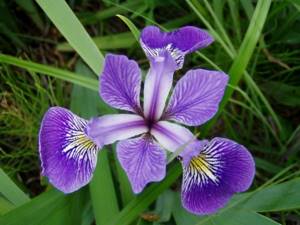
Iris
Be sure to leave a distance between flowers, otherwise you risk that by July the spreading plants will simply swallow up their stunted counterparts with their spectacular leaves.
In the video you can see photos and names of decorative perennials blooming all summer.
Daisies
Graceful daisies can fit into absolutely any style of landscape design. White varieties can serve as a backdrop for colorful arrangements, such as pansies, while pink daisies pair beautifully with ferns. Hyacinths, forget-me-nots and crocuses can also become spectacular neighbors for daisies.
When caring for daisies in the garden, it is important to adhere to the following rules:
- water them in a timely manner, preventing the soil from drying out;
- prevent strong growth of biennials, replacing them with young plants;
- regularly loosen the soil to prevent crust formation;
- apply fertilizers that promote the production of color pigments.
Daisies tolerate frost well, the main thing is to insulate them with breathable coatings that do not allow them to damp out. Spruce spruce branches with a top layer of fallen leaves are suitable.
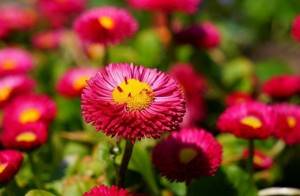
Marigold
Symbolizing the elusive warmth of summer, marigolds can be sown in open ground in May, and when growing seedlings, they begin to grow them in March. Flowers do well in shade and partial shade. For them, frequent watering is recommended before flowering and moderate watering from its beginning until the end of the growing season before frost.
In addition, you must adhere to the following rules for caring for marigolds:
- feed the flowers with mineral solutions twice, when the seedlings grow to 10 cm, and during the budding period;
- treat flowers several times a season prophylactically against caterpillars and spider mites;
- do not mulch the soil during flowers, instead loosening it once again;
- Water the flowers on time: drought deprives them of their decorative properties.
Marigolds of almost all varieties can reproduce excellently by self-sowing, which makes them an excellent choice for creating a picturesque “wild” corner in the garden that requires very little care.
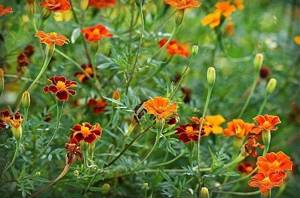
Indoor flowers on the street
What flowers are desirable to take outside in the summer? Trachycarpus, dates, and some orchids will feel good in the fresh summer air. You can safely keep araucaria, indoor roses, hydrangea, hibiscus and euonymus in your yard.
What flowers can be put outside in summer? Indoor plants that are resistant to temperature changes can spend the summer holidays outside: fatshedera, primrose, helxina, and from orchids - cymbidium.
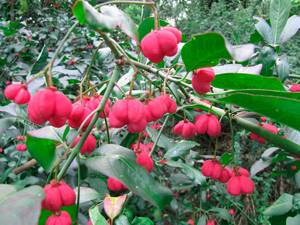
Mediterranean plants like to spend the summer outdoors: all types of citrus fruits, myrtle, palm trees. If you grow succulents such as adenidum and acocanthera, then don’t be afraid to take them out into the garden for the whole summer.
- Photos of abelia species
What flowers do not need to be taken out into the fresh air in summer? Aloe, dracaena, fuchsia, zamioculcas, plumbago (or plumbago), aralia, desert cacti will feel equally good both indoors and outdoors. The choice is yours.
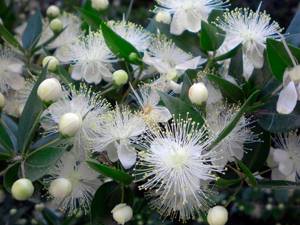
What flowers should not be kept outside? You should not put the following indoor flowers outside even in summer: decorative begonias, some types of violets, dieffenbachia, deciduous cacti, as well as nephrolepis, adiantum.
It is also better for alocasias, anthuriums, indoor arrowroots, monsteras, and philodendrons not to leave the premises, even in warm summers. One cold night or unexpected rain can be fatal for these tropical plants.

Roses
Ground cover (creeping) roses are distinguished by their low height - the group arose as a result of the hybridization of rose hips with the climbing rose “Vihura”, which endowed the new plants not only with unique decorative flowers, but also with resistance to low temperatures and diseases.
It takes only 2 years for creeping roses to form a dense carpet, for dwarf varieties not exceeding 45 cm. The varieties deserve special attention:
- Scarlet - double ruby-scarlet flowers open so thickly that they almost hide the glossy leaves underneath. Scarlet does not need annual pruning.
- Amber Garden - captivates with a unique combination of reddish foliage and creamy yellow flowers, collected in clusters of 5-8 pieces. The smell is weaker than other varieties, but it smells like caramel.
- Snow Ballet - snow-white flowers with a diameter of 6–8 cm have 25 petals, which gives them aristocratic splendor. In rainy summers, some flowers may be damaged.
Gardeners to gardeners
Summer is clearly late this year. Low temperatures and heavy rains forced many summer residents to linger in their city apartments.
It seemed that the long-awaited warmth would never come, so many gardeners abandoned growing flower seedlings. And what's the point? The batteries were turned off, and the temperature in the apartments did not rise above + 14 degrees.
And the sun was almost invisible. In such conditions, heat-loving flower crops most likely would not even sprout.
With the arrival of June, temperatures in most regions of Russia began to rise above + 26 degrees.
And people literally rushed to their summer cottages and gardens. Those gardeners who grow beautifully flowering perennials and ornamental shrubs fully experience the beauty of their flowering garden.
But what about those who just bought a plot or annually planted only annual flowers grown through seedlings in their flowerbeds? Are they really not destined to admire the bright, beautiful flower beds this year?
It is to them that we say: “Believe me, nothing bad happened! We will be happy to help you create the most lush flower beds with bright, fragrant flowers that will delight the eye from July to late autumn.
In this article we will tell you what annual and biennial flowers you can sow in June so that you can admire their marvelous beauty and bright colors already in July.

WHAT FAST-GROWING ANNUAL FLOWERS CAN BE SOUNTED IN A FLOWER FLOWER IN JUNE
We bring to your attention the most unpretentious, fast-growing and very beautiful annual flowers, the seeds of which you can buy from us today.
They are so diverse in size, shape, palette of colors and shades that they can be used to create a variety of forms of flower beds (single-tiered and multi-tiered), flower beds, borders, ridges, curly vertical walls, and carpet lawns.
And caring for these flowers is very minimal and can be done by anyone, even a novice gardener.
And here they are - our best annual flowers that you can sow in June, so that already in July you can admire the amazing beautiful flower beds created with your own hands.
Annual flowers that will bloom 28 - 35 days (depending on the variety) after sowing.
Nasturtium. One of the most beautiful and unpretentious annuals, blooming in July (when planted in June) and blooming until the first serious frost. Plant height (depending on variety): bush – 30 – 40 cm; the length of climbing vines is up to 1.5 m.
You need to sow seeds only in well-lit places with fertile neutral or slightly acidic soil. Sowing depth is 3 cm. It grows very quickly. The flowers are bright - yellow, orange, red, chocolate-golden (depending on the variety). They are shaped like small gramophones.
After sowing, it needs daily watering (in hot weather), and every other day in cool but dry weather. When the bush blooms, water no more than once a week.
You can make wall compositions from vines, use them to decorate verandas, gazebos, and drape unsightly structures.
The earliest and most beautiful varieties of nasturtium : Indian Princess, Mahogany Glim, Peach Melba.
Very beautiful, bright sets : First Beauty, Glim bright set.
Calendula (marigold). When planted in June, it will bloom in July and will bloom until the first snow. A very unpretentious plant. Tolerates temperature changes well.
Loves sun, fertile, light, well-permeable soils with a neutral or slightly acidic reaction. The height of the bushes is from 30 to 60 cm (depending on the variety).
Quite a drought-resistant plant. Before emergence, it requires daily watering, and then it is reduced to once a week.
The earliest and most beautiful varieties of calendula : Orange Porcupine, Neon, Pink Surprise, Red with a black center, Tansy apricot (terry).
Very nice early color set : Pacific Charm .
Marigolds (tagetes). Very bright, yellow, orange, chocolate with a golden border or stripes, low (20 cm) and very large (up to 70 cm) with a pleasant spicy aroma.
Surprisingly unpretentious, drought-resistant. They never get sick or are affected by pests. Moreover, they repel pests from all flowers and vegetable crops growing next to them.
They bloom in the second half of July and disappear into the snow in late autumn.
The best varieties of marigolds from our collection:
Strawberry blond, Mr. Majestic terry, Kurt jester, Discovery orange, Discovery yellow, Pascal, Fireball, Kilimanjaro, Golden age, Bonanza bolero, Carmen, Cupid orange, Span yellow, Mary Helen, Orange king, Mandarin Jam, Span lemon, Eskimo , Hawaiian, Span orange.
Very beautiful sets of early varieties: Discovery yellow-orange, Favorite, Maximix, Kalando.
Annual flowers that will bloom in 38 – 45 days (depending on the variety).
Amaranth (or amaranth) is a very spectacular tall annual with a height of 40 to 70 cm with long clusters of small flowers - dark red, orange, scarlet, burgundy and even emerald with multi-colored foliage.
Very decorative and useful (used in folk and traditional medicine). Loves sun and frequent watering. Prefers soils rich in organic matter - neutral or slightly acidic.
Our best amaranth varieties: Tricolor Yellow, Paniculate Oeschberg, Tricolor Early Magnificent, Tailed Emerald, Tailed Red.
Delphinium (spur or larkspur). A very beautiful annual flower with a delicate pink, white, pale lilac, blue color of rather large inflorescences collected in racemes.
Loves sun, fertile neutral soils, frequent watering. When sown in the first half of June, it will bloom by the end of July and will decorate any flower garden until the end of October.
Our best delphinium varieties. “Magic Fountains” Series: Cherry Blossom, Lavender, Sky Blue, Dark Blue.
Magnificent sets of different early varieties: Tsarsky, Vysokoy, Pacific Ocean.
Gypsophila. This amazingly beautiful annual grows in the form of a bush up to 65 cm high. Its stems are covered with small silver-green leaves and small delicate white flowers with a very pleasant aroma.
Looks stunning in the last row of three-row flower beds in combination with other brighter flowers. It blooms a month and a week after sowing and blooms until late autumn.
Can grow in diffuse partial shade on fertile, neutral soils. Loves frequent watering.
Cut branches can be dried and used to create flower arrangements in the Ikebana style.
The best variety of gypsophila is Snezhinka.
Nigella . A very spectacular annual flower 30–45 cm high with thin feathery soft green leaves. Its bright (red, blue, purple, pink and pale blue) flowers located at the ends of the stems look very impressive.
Blooms by the end of July. Flowering continues until the end of October.
Nigella loves sun, fertile, organic-rich soil and frequent watering. Very unpretentious.
A unique set of different early varieties: Persian Jewels.
Mattiola. We recommend that you sow this amazing flower under your bedroom window. Its surprisingly subtle, delicate, sweet (magnolia-like scent) aroma will give you true pleasure.
The flower is very unpretentious, can grow in diffuse partial shade, loves fertile soil with a neutral reaction.
The best variety of matthiola from our collection: Wonderful aroma.

OUR BEST SETS OF ANNUAL FLOWERS FOR SOWING IN JUNE DIRECTLY IN FLOWER BEDS
To decorate your garden with luxurious annual flowers, our professional designers have compiled unique sets of seeds for you, which you can sow now and within a month begin to admire the first blooming flowers.
The flowers we offer combine very well with each other in each set - in color, shape and size. Each set is designed for a separate flowerbed or edging.
The flowers on it will bloom gradually, until the first ten days of August, and then they will all bloom together in full force, delighting you with the richness of colors and whimsical shapes.
Introducing these amazing sets:
Starry summer, Simple annuals, Candy in powdered sugar, The most beautiful vines, Kiss of the sun, Calibrachoa paradise island, Mountain lavender, Fireworks on Victory Day, A set of annuals to attract butterflies.
Now you know what annual flowers you can sow in June to amazingly transform your plot, turning it into a blooming garden.
You can buy all of the above annual flowers and their varieties from us today!
Coreopsis
With a flower shape reminiscent of cosmos, coreopsis exists in many varieties, but almost all of them are yellow. In a smaller assortment, there are those in which the golden-sunny tone is combined with dark red, as well as pink and white-red.
And before decorating your garden with a certain variety, it is important to clarify whether the coreopsis variety has its own unique preferences. For example, coreopsis:
- large-flowered - requires minimal soil moisture;
- pink - flowers lose their decorative appearance on fertile soils;
- whorled - will bloom profusely and for a long time if pruned after the first wave of flowering;
- lanceolate - flowers respond positively to the application of organic fertilizers.
To preserve their decorative appearance and maintain vitality, coreopsis plants, with the exception of whorled ones, should be divided and replanted every 3 years.
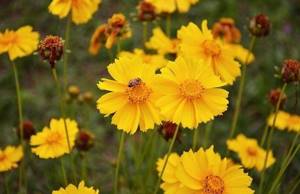
Perennial chrysanthemum
Most gardeners consider the chrysanthemum to be an “autumn” flower, but theoretically it can be made to bloom in summer, for which the bushes are left to overwinter in the cellar at temperatures up to +8 ° C, and then in February they are transferred to a warm place, divided into shoots and formed into bushes.
Among gardeners, the following chrysanthemum varieties are annually popular:
- Talisman is a compact shrub, not exceeding 30-35 cm, densely so that the stems are not visible, strewn with bright crimson semi-double flowers;
- Branbeach Sunny - a bush up to 50 cm tall stands out in any composition due to its double bright yellow flowers with a diameter of about 8 cm, the variety can bloom as early as the end of July;
- Elf White - small simple flowers up to 3.5 cm in diameter, snow-white and similar to chamomile due to the lemon center; the spherical bush grows up to 45–50 cm.
The best site for chrysanthemums is considered to be one where the soil is loamy, fertile, and not prone to waterlogging. A mixture of compost and peat must be added to planting holes for flowers.
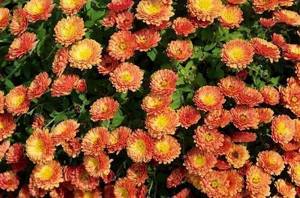
In conclusion, it is worth adding that all of the named types of flowers, with the exception of roses, can be perfectly combined with each other in landscape compositions. It is recommended to plant roses separately.

